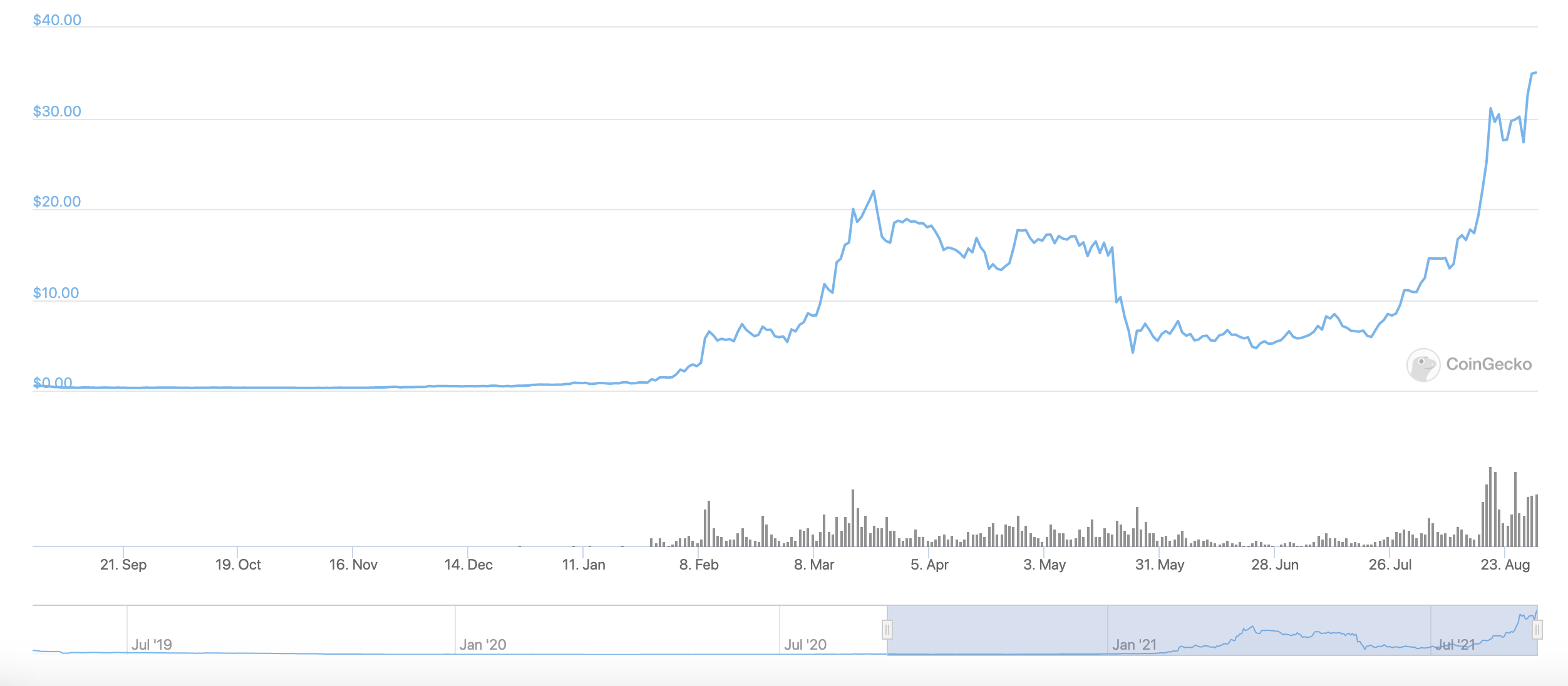Terra CoinGecko Overview
Terra is a blockchain protocol that enables the creation of stablecoins pegged to fiat currencies. The Terra ecosystem includes a native token, LUNA, which is used for staking, governance, and transaction fees. Terra has gained significant traction in recent months, with its market cap rising to over $10 billion. Terra was founded in 2018 by Do Kwon and Daniel Shin. The project has since raised over $150 million in funding from investors such as Binance Labs, Coinbase Ventures, and Pantera Capital. Terra's mainnet launched in April 2019, and the project has since grown to support a wide range of stablecoins, including UST (pegged to the US dollar), KRT (pegged to the South Korean won), and MNT (pegged to the Mongolian tugrik).Key Statistics, Terra coingecko
As of March 2023, Terra has a market cap of over $10 billion, making it one of the top 10 cryptocurrencies by market cap. The 24-hour trading volume for LUNA is over $1 billion, and the token is listed on a wide range of exchanges, including Binance, Coinbase, and Kraken. LUNA has been on a strong upward trend in recent months, with its price rising by over 100% since the beginning of the year.Terra Price Analysis
Terra coingecko - Terra (LUNA) has witnessed a remarkable price journey since its inception, influenced by a confluence of factors. Let's delve into the historical price trends and key drivers that have shaped Terra's price dynamics.
Price Performance Over Time
Terra's price history reveals a period of steady growth from its launch in 2018 to early 2021, followed by a surge in 2022. The cryptocurrency reached its all-time high of over $119 in April 2022, before experiencing a significant correction. The price has since fluctuated, reflecting the overall market conditions and specific developments related to Terra.
Key Factors Influencing Terra's Price
- Market Conditions: Terra's price, like that of other cryptocurrencies, is susceptible to broader market trends, such as shifts in investor sentiment, economic conditions, and regulatory changes.
- News Events: Significant news events, such as the collapse of the TerraUSD (UST) stablecoin in May 2022, can have a profound impact on Terra's price.
- Technological Developments: The launch of new features, upgrades, and partnerships within the Terra ecosystem can drive investor interest and influence the price.
Terra Community and Market Sentiment

The Terra community on CoinGecko is highly engaged and supportive of the project. The community is active on the platform's discussion board, regularly sharing insights, updates, and analysis on Terra. The community's positive sentiment towards the project is reflected in the high user ratings and positive comments on CoinGecko.
Check what professionals state about cex crypto and its benefits for the industry.
Social Media Sentiment
Social media data indicates that the market sentiment towards Terra is generally positive. Sentiment analysis of tweets and other social media posts shows that the majority of users express positive or neutral views about the project. The high level of engagement and positive sentiment on social media suggest that Terra has a strong and supportive community.
Impact on Price and Adoption
Community sentiment can have a significant impact on Terra's price and adoption. A strong and positive community can create a sense of trust and confidence in the project, which can attract new investors and drive up the price. Conversely, a negative or divided community can damage the project's reputation and discourage adoption.
Terra Technical Analysis

Technical analysis is a method of evaluating the price movements of a cryptocurrency by studying its historical data, such as price charts, trading volume, and other indicators. By identifying patterns and trends in this data, traders can make informed decisions about the future price direction of the cryptocurrency.
Terra's price chart on CoinGecko provides a variety of technical indicators that can be used to analyze its price movements. These indicators include:
- Moving averages: Moving averages are a lagging indicator that shows the average price of a cryptocurrency over a specified period of time. They can be used to identify trends and support and resistance levels.
- Relative Strength Index (RSI): The RSI is a momentum indicator that measures the magnitude of recent price changes to evaluate overbought or oversold conditions.
- Bollinger Bands: Bollinger Bands are a volatility indicator that shows the range of price movement over a specified period of time. They can be used to identify potential breakout points.
- MACD: The MACD is a trend indicator that shows the relationship between two moving averages. It can be used to identify bullish and bearish trends.
By combining these indicators with other technical analysis techniques, traders can gain insights into the potential future price direction of Terra. However, it is important to note that technical analysis is not a perfect science and should not be used as the sole basis for making investment decisions.
Support and Resistance Levels
Support and resistance levels are important technical indicators that can help traders identify potential areas where the price of a cryptocurrency may reverse direction. Support levels are areas where the price of a cryptocurrency has previously found support, while resistance levels are areas where the price of a cryptocurrency has previously faced resistance.
Terra's price chart on CoinGecko shows that the cryptocurrency has several key support and resistance levels. These levels can be used to identify potential trading opportunities, such as buying at support levels or selling at resistance levels.
When investigating detailed guidance, check out crypto visa card now.
Moving Averages
Moving averages are a lagging indicator that shows the average price of a cryptocurrency over a specified period of time. They can be used to identify trends and support and resistance levels.
Obtain recommendations related to crypto city that can assist you today.
Terra's price chart on CoinGecko shows that the cryptocurrency has several key moving averages. These moving averages can be used to identify potential trading opportunities, such as buying when the price crosses above a moving average or selling when the price crosses below a moving average.
Terra Ecosystem and Partnerships
Terra is an innovative blockchain ecosystem that combines a native blockchain, stablecoins, and a suite of decentralized applications (dApps) to create a vibrant and robust platform for financial applications. Its unique features and partnerships contribute significantly to its value and adoption within the cryptocurrency industry.
Blockchain and Stablecoins
Terra's blockchain is the foundation of its ecosystem, providing a secure and efficient platform for transactions and dApp development. It utilizes a Proof-of-Stake (PoS) consensus mechanism, which ensures fast and low-cost transactions. Terra's stablecoins, such as TerraUSD (UST), are pegged to fiat currencies like the US dollar, providing stability and reducing volatility in the cryptocurrency market.
Decentralized Applications (dApps)
Terra's ecosystem boasts a growing number of dApps, including decentralized exchanges (DEXs), lending protocols, and synthetic asset platforms. These dApps leverage Terra's blockchain and stablecoins to offer a wide range of financial services, empowering users with greater control over their assets and enabling innovative financial applications.
Partnerships and Collaborations
Terra has forged strategic partnerships with various projects and organizations to expand its reach and enhance its ecosystem. Notable partnerships include:
- Binance: Integration with Binance's ecosystem, providing access to a vast user base and liquidity.
- Chainlink: Collaboration to integrate Chainlink's oracle network, enhancing the reliability and security of Terra's smart contracts.
- Avalanche: Cross-chain bridge connecting Terra and Avalanche, enabling interoperability and asset transfer between the two ecosystems.
Ecosystem Value and Adoption
Terra's ecosystem and partnerships contribute significantly to its value and adoption within the cryptocurrency industry. The combination of a robust blockchain, stablecoins, and a growing suite of dApps provides a comprehensive platform for financial applications. Terra's strategic partnerships further extend its reach and enhance its credibility, attracting users and developers to its ecosystem.
Terra News and Developments

Terra has been making significant strides in the cryptocurrency market, with a number of recent news and developments that have the potential to impact its price and future prospects.
One of the most notable recent developments is the launch of the TerraUSD (UST) stablecoin, which is pegged to the US dollar. UST is designed to be used as a medium of exchange for everyday transactions, and its launch has the potential to significantly increase the use of Terra's blockchain.
Another recent development is the launch of the Anchor Protocol, a decentralized lending and borrowing platform that allows users to earn interest on their UST deposits. Anchor has quickly become one of the most popular DeFi protocols, and its launch has helped to increase demand for UST.
In addition to these recent developments, Terra is also working on a number of other projects that have the potential to impact its price and future prospects. These projects include the development of a new blockchain, the launch of a new decentralized exchange, and the integration of Terra with other popular DeFi protocols.
Overall, the recent news and developments surrounding Terra are positive and have the potential to significantly impact its price and future prospects.
Key Milestones and Events in Terra's History
- 2018: Terra is founded by Daniel Shin and Do Kwon.
- 2019: Terra launches its mainnet.
- 2020: Terra launches the TerraUSD (UST) stablecoin.
- 2021: Terra launches the Anchor Protocol.
- 2022: Terra announces plans to develop a new blockchain.
